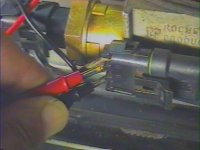- Thread starter
- #21
jeanie2002
Active member
GeekyBill could be right about the IACs. However, if you have a large enough vacuum leak the motor will surge like you described and the IACs will try to correct at idle...hence the surging effect. OR you could have very dirty pintles on the IACs and they can't shut properly and could be cycling. You could also have a fuel pressure issue and the only way to find that out is by checking in-between the TBs and see what it is set to, 13-14psi is plenty as long as the pump can output the volume under load.
A quick "gross" check of the fuel pressure to kind of see where you're at thing can be done by looking at the back of the rear TB, there's a small window (cutout) area that you can see into on the tower, thats the fuel pressure regulator can, "tab" and spring through there. Look inside with a flashlight and see where the "tab" is sitting in the slot. If it's at the bottom or really close to the bottom, your FP is low. You want the "tab" to be about half to 3/4 of the way up the slot. Again, this is only a "gross" check to get a feel of where your at.
I'm willing to bet that if its at the bottom that your FP is only around 9-10psi and is running the motor pretty lean. Check it with a gauge to find out for sure though. Also check the fuel filter/replace and maybe the pump filter/sock in the tank.
Since you said the headlights were working (coming up) and now they don't and they are run strictly by vacuum, I'd start there first, then the top plate or whichever you want first and then proceed from there. I would also think that if the vacuum was too low that you would be setting a MAP Sensor 33 or 34 code maybe.
There's a pretty good vacuum troubleshooting diagram in the Tech Section over at the CFI forum, check it out. CrossFire Injection Forum
So, since you aren't getting a CEL during operation, that would indicate that the issue is mechanical in nature whereby the ECM is not controlling or monitoring that problem and thinks everything is fine which would also eliminate a sensor input for now. It could also be the ECM, but that would be my last thing I checked. So to sum it up, we're back to either fuel or vacuum or both and of course a possible IAC issue.
The best thing you can buy is a GM Service Manual off of Fleebay or something for a car that is 28 years old and you want to maintain it, just a suggestion and well worth the money spent. Good luck and hope you find the root cause.
I checked tab and it is at bottom, at idle injectors have a good spray, but on acceleration dead spot at about 25% throttle at which time spray drops to almost nothing but push further and spray comes back. Is spray going away because of dead spot or lack of spray causing dead spot? Since this is an electric pump I would assume fuel should be at constant pressure, however if pump was not delivering why does spray return when pushing past dead spot? I can push to almost full throttle and no problem, all this was done with car parked. I thought if I could get full throttle in park I could on the road, but again falls on its face no power,have to continuously pump pedal to keep car from dying. This pump is old and I am going to go ahead and replace it, but this is just confusing me. Could oil pressure switch be acting up? Thanks











